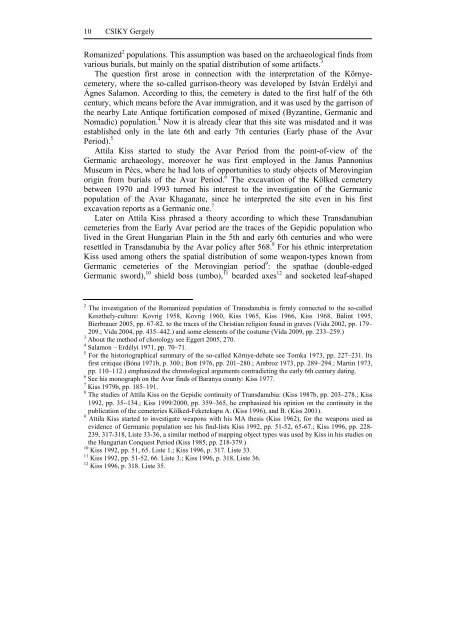Download - Facultatea de Științe Socio-Umane - Universitatea ...
Download - Facultatea de Științe Socio-Umane - Universitatea ...
Download - Facultatea de Științe Socio-Umane - Universitatea ...
Create successful ePaper yourself
Turn your PDF publications into a flip-book with our unique Google optimized e-Paper software.
10<br />
CSIKY Gergely<br />
Romanized 2 populations. This assumption was based on the archaeological finds from<br />
various burials, but mainly on the spatial distribution of some artifacts. 3<br />
The question first arose in connection with the interpretation of the Környecemetery,<br />
where the so-called garrison-theory was <strong>de</strong>veloped by István Erdélyi and<br />
Ágnes Salamon. According to this, the cemetery is dated to the first half of the 6th<br />
century, which means before the Avar immigration, and it was used by the garrison of<br />
the nearby Late Antique fortification composed of mixed (Byzantine, Germanic and<br />
Nomadic) population. 4 Now it is already clear that this site was misdated and it was<br />
established only in the late 6th and early 7th centuries (Early phase of the Avar<br />
Period). 5<br />
Attila Kiss started to study the Avar Period from the point-of-view of the<br />
Germanic archaeology, moreover he was first employed in the Janus Pannonius<br />
Museum in Pécs, where he had lots of opportunities to study objects of Merovingian<br />
origin from burials of the Avar Period. 6 The excavation of the Kölked cemetery<br />
between 1970 and 1993 turned his interest to the investigation of the Germanic<br />
population of the Avar Khaganate, since he interpreted the site even in his first<br />
excavation reports as a Germanic one. 7<br />
Later on Attila Kiss phrased a theory according to which these Transdanubian<br />
cemeteries from the Early Avar period are the traces of the Gepidic population who<br />
lived in the Great Hungarian Plain in the 5th and early 6th centuries and who were<br />
resettled in Transdanubia by the Avar policy after 568. 8 For his ethnic interpretation<br />
Kiss used among others the spatial distribution of some weapon-types known from<br />
Germanic cemeteries of the Merovingian period 9 : the spathae (double-edged<br />
Germanic sword), 10 shield boss (umbo), 11 bear<strong>de</strong>d axes 12 and socketed leaf-shaped<br />
2 The investigation of the Romanized population of Transdanubia is firmly connected to the so-called<br />
Keszthely-culture: Kovrig 1958, Kovrig 1960, Kiss 1965, Kiss 1966, Kiss 1968, Bálint 1995,<br />
Bierbrauer 2005, pp. 67-82. to the traces of the Christian religion found in graves (Vida 2002, pp. 179–<br />
209.; Vida 2004, pp. 435–442.) and some elements of the costume (Vida 2009, pp. 233–259.)<br />
3 About the method of chorology see Eggert 2005, 270.<br />
4 Salamon – Erdélyi 1971, pp. 70–71.<br />
5 For the historiographical summary of the so-called Környe-<strong>de</strong>bate see Tomka 1973, pp. 227–231. Its<br />
first critique (Bóna 1971b, p. 300.; Bott 1976, pp. 201–280.; Ambroz 1973, pp. 289–294.; Martin 1973,<br />
pp. 110–112.) emphasized the chronological arguments contradicting the early 6th century dating.<br />
6 See his monograph on the Avar finds of Baranya county: Kiss 1977.<br />
7 Kiss 1979b, pp. 185–191.<br />
8 The studies of Attila Kiss on the Gepidic continuity of Transdanubia: (Kiss 1987b, pp. 203–278.; Kiss<br />
1992, pp. 35−134.; Kiss 1999/2000, pp. 359–365, he emphasized his opinion on the continuity in the<br />
publication of the cemeteries Kölked-Feketekapu A. (Kiss 1996), and B. (Kiss 2001).<br />
9 Attila Kiss started to investigate weapons with his MA thesis (Kiss 1962), for the weapons used as<br />
evi<strong>de</strong>nce of Germanic population see his find-lists Kiss 1992, pp. 51-52, 65-67.; Kiss 1996, pp. 228-<br />
239, 317-318, Liste 33-36, a similar method of mapping object types was used by Kiss in his studies on<br />
the Hungarian Conquest Period (Kiss 1985, pp. 218-379.)<br />
10 Kiss 1992, pp. 51, 65. Liste 1.; Kiss 1996, p. 317. Liste 33.<br />
11 Kiss 1992, pp. 51-52, 66. Liste 3.; Kiss 1996, p. 318, Liste 36.<br />
12 Kiss 1996, p. 318. Liste 35.





